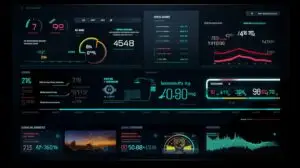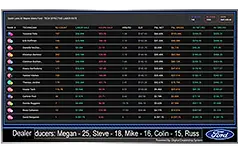Are you hoping to see sales rise in your dealership? If so, then efficient tracking of sales BDC performance is the answer.
Monitoring key metrics and utilizing tactics to increase performance can lead to improved results and expanded income.
In this blog, I’ll explore the relevance of sales BDC performance tracking, look at key metrics to observe, and give strategies to improve performance.
With the appropriate approach and regular assessment, you can take your dealership’s sales to new levels.
Key Takeaways
Tracking the success of your Sales BDC is essential for boosting sales in your dealership. Analyzing key metrics and initiating enhancement strategies will ensure your team is constantly achieving its objectives.
Communicating and working together with your sales team and using CRM software will further aid their performance.
Always keep an eye on and examine the performance of your Sales BDC for long-term success.
Importance of Sales BDC Performance Tracking

You can’t afford to neglect the significance of monitoring your Sales BDC effectiveness if you want to experience unprecedented growth in your dealership.
Tracking your Sales BDC performance permits you to identify areas for improvement and make decisions based on data to maximize your team’s productivity and efficiency.
Monitoring your Sales BDC performance offers valuable insights into the effectiveness of your sales procedures. By keeping an eye on vital metrics such as lead conversion rates, response times, and appointment set rates, you can detect inefficiencies in your sales funnel and introduce tactics to optimize your team’s performance.
Tracking your team’s performance lets you recognize top performers and provide specific training and coaching to those who may be struggling.
Tracking your Sales BDC performance enables you to analyze the impact of your marketing initiatives. By monitoring lead sources and conversion rates, you can determine which marketing channels are generating the most qualified leads and allocate your resources accordingly.
To summarize, tracking your Sales BDC performance is essential for achieving sales growth in your dealership. It provides useful insights, allows for specific training and coaching, and helps you optimize your marketing initiatives.
Key Metrics for Monitoring BDC Performance

Getting the right metrics is essential for effectively tracking BDC performance and achieving desired results. By monitoring key metrics, you can gain valuable insights into how your sales BDC is functioning and spot areas for improvement.
One key metric to keep an eye on is lead response time. How quickly your BDC team responds to leads can have a huge effect on conversion rates. A fast response time shows potential customers that you value their business and increases the chances of closing a sale.
Another metric to consider is the appointment set rate. This measures the percentage of leads that result in scheduled appointments. A high appointment set rate demonstrates that your BDC team is successfully engaging with leads and convincing them to take the next step.
Tracking the appointment show rate is critical. This metric measures the percentage of scheduled appointments that actually show up. A high show rate shows that your BDC team is setting solid appointments.
By tracking these key metrics, you can recognize areas where your BDC performance could be lacking and develop strategies for improving sales growth in your dealership. Moving into the next section about strategies for improving BDC performance, it is essential to focus on training and coaching your BDC team to excel in these key metrics.
Strategies for Improving BDC Performance

Maximizing the potential of a BDC team is essential for success. To do this, effective strategies must be put in place to drive improved performance. Regularly monitoring key metrics, such as call volume, appointment setting, and lead conversion rates, is an important way to identify areas of improvement. With this data, corrective actions can be taken to boost team performance.
It is also beneficial for the BDC team to receive ongoing training and development. This could include teaching effective communication, handling objections, and product knowledge. By investing in team development, they will be better equipped to excel in their roles.
Technology is another strategy that can enhance BDC performance. Utilizing customer relationship management (CRM) software to track and manage leads, as well as automated email and text messaging campaigns to stay in contact with potential customers, is an important way to improve efficiency.
By implementing these strategies, sales growth in the dealership can be achieved. Collaboration between the BDC and sales teams is also essential to this goal. Open communication and collaboration will ensure that leads are passed on smoothly and efficiently.
Effective Communication and Collaboration with the Sales Team

Effective communication and collaboration between the BDC and sales team are essential for optimizing BDC performance and achieving sales success. Open lines of communication and teamwork are key in ensuring everyone is on the same page and working toward a shared goal.
Regular meetings and updates can help keep everyone informed about lead status, appointments, and sales prospects. Training sessions and cross-department projects are also useful for improving performance between both teams.
Using customer relationship management (CRM) systems can also optimize BDC performance. These systems streamline communication, track customer interactions, and provide valuable data for sales and marketing. Integrating CRM systems into dealership operations can improve the efficiency and effectiveness of communication and collaboration between the BDC and sales team, leading to increased sales growth.
Utilizing Customer Relationship Management (CRM) Systems

CRM systems act as a central hub for managing customer data, allowing sales representatives to access information in real time. This helps create a more personalized sales process, as sales team members can better identify customer needs and tailor their approach accordingly.
CRM systems also offer insight into customer behavior, which dealerships can use to inform marketing strategies, inventory management, and customer retention plans.
With a CRM system, the BDC can quickly pass on customer information to the sales team, ensuring representatives are prepared for customer interactions. This increases customer satisfaction and leads to higher sales. The system also supports ongoing communication and feedback between the BDC and sales team, allowing them to address customer concerns and needs quickly.
Regular monitoring and evaluation are essential to ensure the system is being used correctly and any issues are addressed promptly. This evaluation allows dealerships to make necessary adjustments and improvements, keeping the sales team on track and maximizing the potential of the CRM system.
Continuous Monitoring and Evaluation of BDC Performance

Keep a close watch on how well your BDC is doing by continually monitoring and evaluating their progress. This is essential for increasing sales in your dealership.
Here are four key points to note when monitoring and evaluating BDC performance:
- Set clear objectives: Establish specific and measurable goals for your BDC team. This will help them understand what is expected from them and create a standard for assessment.
- Track important metrics: Monitor essential metrics such as lead conversion rate, response time, appointment setting rate, and overall sales performance. Regularly analyze these metrics to identify any room for improvement or potential issues.
- Offer regular feedback: Provide constructive feedback to your BDC team on a regular basis. Highlight their accomplishments and point out areas that need to be improved. This will help them stay motivated and continually work towards better performance.
- Implement training and development plans: Invest in training and development programs to enhance your BDC team’s skills and knowledge. This will help them stay up-to-date with industry trends and improve their performance.
By monitoring and evaluating BDC performance continuously, you can pinpoint areas for improvement, optimize your processes, and ultimately drive sales in your dealership.
Conclusion – Sales BDC Performance Tracking 101
Tracking the success of your Sales BDC is critical to increasing sales in your dealership. Analyzing key metrics and implementing improvement strategies will ensure your team is consistently achieving its goals.
Communication and collaboration with your sales team and utilizing CRM software will further help their performance. Remember to constantly monitor and assess the performance of your Sales BDC for long-term success.
SEO standards should be kept in mind when writing at a high school level. Write in a natural style, utilizing a mix of short, medium, and long sentences.
Frequently Asked Questions
How can sales BDC performance tracking benefit other departments within a dealership?
Sales BDC performance tracking can bring multiple benefits to other departments within a dealership. It provides useful data and insights that the marketing team can use to refine their advertising strategies.
It also allows the service department to spot customer trends and improve customer service. It assists the finance department by tracking lead conversions and giving accurate data for budgeting and forecasting.
Sales BDC performance tracking can enhance collaboration and efficiency across departments.
What are some common challenges dealerships face when implementing sales BDC performance tracking?
Dealerships often face difficulties when setting up sales BDC performance tracking. Staff may be unwilling, seeing it as intrusive or something that takes away their independence. Data must be collected accurately and constantly, and the right technology must be found to keep track of and evaluate performance.
Training and understanding may be lacking when it comes to analyzing and taking advantage of the collected data, which can make it hard to create meaningful improvements.
What are some potential obstacles that can hinder the effectiveness of strategies for improving BDC performance?
Potential obstacles that can impede the effectiveness of strategies for improving BDC performance include:
- Inadequate training and development for BDC agents
- Lack of communication and coordination between the BDC and sales team
- Outdated technology and tools
Other obstacles include:
- Clear goals and performance metrics
- Reluctance to change within the dealership
Resolving these issues and creating an effective plan for improvement is essential for the successful implementation of strategies.
Can you provide examples of how effective communication and collaboration with the sales team can positively impact BDC performance?
Effective communication and collaboration with the sales team can have a great impact on BDC performance.
For instance, when the two teams combine their efforts, they can gain valuable customer insights and feedback, which leads to improved customer service and higher conversion rates.
Maintaining regular communication between the two teams also helps with coordinating sales and follow-up activities, ensuring that the customer experience is as smooth as possible.
Through this collaboration, there is a stronger sales culture and higher sales growth.
Zach White is a dynamic and insightful writer specializing in the field of digital sign systems and technology. With a keen eye for the latest trends in digital signage and a deep understanding of the technology that powers them, Zach has made a significant impact in the industry through his engaging and informative content.
His journey began with a fascination for the intersection of technology and visual communication. This passion led him to pursue a degree in Communication Technology, where he honed his skills in both technical understanding and effective communication.
Zach’s articles and blogs, known for their clarity and depth, have helped demystify complex digital signage technologies for a wide audience. His work not only covers the technical aspects but also delves into the creative possibilities of digital signs, offering valuable insights for both industry professionals and enthusiasts.
As a writer for a leading digital signage company, Zach plays a crucial role in educating and inspiring his readers about the potential of digital sign systems in transforming public spaces, advertising, and information dissemination. His ability to explain intricate technical details in an accessible manner has made him a sought-after voice in the field.
In addition to his writing, Zach is an active participant in industry conferences and seminars, where he shares his knowledge and stays abreast of emerging technologies. His commitment to staying at the forefront of digital signage innovations ensures that his readers always get the most current and relevant information.
Zach’s contributions to the field have not only earned him respect among his peers but have also made a tangible difference in how digital sign systems are perceived and utilized in the modern world.




